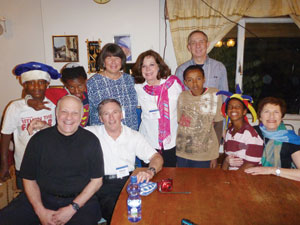 Just last year I read the best-selling novel, “Cutting for Stone,” by Abraham Verghese. The book, set in Addis Ababa, Ethiopia, is a multi-generational saga of Dr. Shiva Stone and his family. As interesting as the book was, I did not add Ethiopia to my bucket list of travel destinations. Ethiopia was too far away, just another third world country offering nothing that would tempt me to visit.
Just last year I read the best-selling novel, “Cutting for Stone,” by Abraham Verghese. The book, set in Addis Ababa, Ethiopia, is a multi-generational saga of Dr. Shiva Stone and his family. As interesting as the book was, I did not add Ethiopia to my bucket list of travel destinations. Ethiopia was too far away, just another third world country offering nothing that would tempt me to visit.
However, I quickly changed my mind about visiting Ethiopia when I received a call from my friend, Bari Freiden. She and her husband, Dr. Floyd Freiden, heard about a JDC mission trip to Ethiopia and Rwanda to visit JDC-IDP projects in those countries. Would we be interested in going with them?
My husband, Dr. Michael Blum, immediately called Trish Uhlmann to get more information about the trip. Trish, who is chair of the international development program of the JDC, was the chair of this trip and was thrilled with the possibility of us joining the group.
I emailed the JDC and told them “yes,” add us to the list.
As we started preparing for the trip, Michael ran into Dr. David Kaplan at Congregation Beth Torah. He subsequently signed up to go on the trip with us. So, on Feb. 7, the six of us from Kansas City joined the other trip participants, including several JDC board members and national staff, for the 13-hour plane ride on Air Ethiopia from Dulles to Addis Ababa.
The ‘Joint’
I was familiar with JDC work in Romania and Russia but was not really familiar with its history or the extent of JDC’s projects throughout the world. For 96 years, the American Jewish Joint Distribution Committee (JDC) — also referred to as “the Joint” — has exemplified the principle that all Jewish people are responsible for one another. JDC’s reach is global, yet it is uniquely equipped to make a deep impact locally.
Active today in more than 70 countries, JDC and its partners work to rescue Jewish lives at risk, bring relief to Jews in need, renew lost bonds to Jewish identity and Jewish culture, and help Israel overcome the social challenges of its most vulnerable citizens, both Jewish and non-Jewish.
The Joint’s IDP
The Joint’s reach extends beyond the global Jewish community by providing non-sectarian disaster relief and long-term development assistance worldwide. Since its inception in 1914, JDC’s non-sectarian efforts in the form of the International Development Program (JDC-IDP) have been carried out in more than 60 countries by offering humanitarian aid to those who have suffered from man-made and natural disasters such as earthquakes, famine, extreme poverty, political instability and war.
JDC-IDP addresses victims’ emergency needs and then provides longer-term rehabilitation and development assistance. Training is an essential part of these efforts, as JDC-IDP works to enhance the abilities of local partners and to ensure that the projects continue even after JDC’s involvement has ended.
All IDP projects are independently funded, with start-up money coming from local governments, NGOs or philanthropists interested in projects in developing countries. The role of the JDC is to assist each project raise the initial funds and to help in the development of the program, with the final goal being for each project to run independently without further assistance from the JDC.
Unity Scholarship Program for Women
One of the outstanding IDC program in Ethiopia is the Unity Scholarship Program that provides young women with full college scholarships, including room and board. In Ethiopia, the number of women enrolled in higher education has traditionally been very low with boys having the priority to attend university if the family can afford to send them. A major donor, Rita Levi-Montalcini from Rome, began the scholarship program that the JDC helps administer. The actual scholarship awards are part of the IDP. It costs just $7,500 to send one young women to the Unity College in Addis for three years, which cost includes room and board.
At a restaurant located on the hill where 14,000 Felasha Jews were encamped before being airlifted to Israel in 1991, we met with 20 young women who had received college scholarships. Most of the young women were current students, but we also met with some of the graduates, all of whom were employed. The local woman in charge of the girl’s dorm, Tegest Heruy, spoke beautifully to our group about the importance of giving talented young women the chance to attend college and how much the recipients are able to give back to their families, communities and Ethiopia. An interesting coincidence is that Tegest’s son and daughter both live in the Kansas City area and Tegest has visited here several times.
IDP projects in Gondar, Ethiopia
On Feb. 13 we flew to Gondar, a one-hour plane ride north of Addis. We immediately drove to one of the rural school projects funded by IDP donors. Even before we entered the school compound, several students rushed out to meet us. After Trish cut a dedication ribbon, we entered the school yard where the voices of more than 100 children greeted us in song. The singing continued as we set up tables where our assignment was to give five de-worming pills to each student in the school. We told each student “swallow, swallow” in Ethiopian as they drank their glass of water. While the students waited in line for their medicine, Michael pulled out his bag of magic tricks and did a few simple sleight of hand tricks. Michael would continue to entertain the children we met, with his largest audience being the 500 students at the Agahozo Shalom Youth Village in Rwanda.
After handing out the last of the pills, we visited some of the classrooms, which were exact replicas of a one-room Kansas prairie school, with desks for the students neatly lined up and a simple chalk board at the front of the room. Before we left the school, we were treated to an Ethiopian coffee ceremony and other refreshments by the school staff.
There were two moments that stood out for me that morning. One was the unveiling of a plaque at the school that read “Salej Kidane Meheret Primary School implemented by the JDC and funded by the Osher Foundation — US February, 2012.”
The other moment was a stop at another village school to see a classroom built with funds raised by the teenage son of one of the JDC board members on our trip. This young man had come to Ethiopia four years earlier with his family. After that trip, this young man decided that he wanted to help build a classroom on his own so he proceeded to raise the cost of one school room, $17,000, from family and friends. We were able to see the finished project and watch the young man’s mother put her hand in cement to dedicate her son’s project.
IDP Projects in Rwanda
In Rwanda, the main IDP program is the Agahozo Shalom Youth Village 40 kilometers east of Kigali, which is home to 500 Rwandan orphans from the ages of 13 to 18. After the Rwandan genocide in 1994, philanthropist Anne Heyman read about the crisis and went to the JDC to discuss a special project she and her family wanted to fund. The JDC assisted in purchasing the land, finding an architect to design the village and working with the local government to obtain building and other permits.
Modeled after the Yemin Orde Youth Village in Israel, every Rwandan village nominates the neediest of its orphans to live in Agahozo Shalom for four years. The selected students spend the first year getting adjusted to living in a location where lack of food and shelter is never a worry. During this first year they also receive extensive counseling to heal their emotional wounds.
I spent time talking to one of the first-year students who spoke beautiful English. He told me about his learning to get along with the other students and about the need for “tikkun olam.” It touched me to hear these Hebrew words coming from a Rwandan orphan. In a country ravaged by hatred and killing less than 20 years ago, the words one student shared with me validated the efforts of the JDC by helping to develop these non-sectarian projects. In a world where there is so much destruction and tearing down, Rwanda is a proud example that a country can be rebuilt and that enemies (the Hutus and the Tutsis, which ethnic designations are no longer used in Rwanda) can learn to live together in peace.
I will be forever grateful that I was able to see for myself the humanitarian work that JDC does for both Jews and non-Jews throughout the world. When Trish called me earlier this week and asked what project we might be interested in funding, my answer was “I really don’t know as it is so hard to choose just one.” Michael and I will decide which project to support after we share our extraordinary trip experiences with our children and our oldest grandson, Mitch. It will be a worthy conversation to have with our family.
 PASSOVER PHONE APP — Just in time for Passover, OU Kosher — the world’s most recognized kosher symbol — has launched a new OU Kosher phone app to search the kosher status of all OU products for Passover and year-round. The free app is available for download for iPhones, iPads, iPod Touch and Androids. To download this app, simply select “OU Kosher” from the iTunes App Store or use direct link to the app from the OU’s website at www.ou.org/apps. The direct application can be downloaded at http://itunes.apple.com/ke/app/ou-kosher/id491138771?mt=8. In addition to the ability to search for more than 600,000 products, manufactured in nearly 8,000 plants, in more than 90 countries around the world — the app provides the most up-to-date kosher alerts; new product updates; and allows easy access to ask a question or to call the OU Kosher information hotline. The app can be used in conjunction with the OU website and Passover Guide. Additionally, the OU Kosher Facebook and Twitter accounts plan to help prepare for the eight-day holiday by featuring kosher for Passover products, recipes and articles to educate and engage fans and followers.
PASSOVER PHONE APP — Just in time for Passover, OU Kosher — the world’s most recognized kosher symbol — has launched a new OU Kosher phone app to search the kosher status of all OU products for Passover and year-round. The free app is available for download for iPhones, iPads, iPod Touch and Androids. To download this app, simply select “OU Kosher” from the iTunes App Store or use direct link to the app from the OU’s website at www.ou.org/apps. The direct application can be downloaded at http://itunes.apple.com/ke/app/ou-kosher/id491138771?mt=8. In addition to the ability to search for more than 600,000 products, manufactured in nearly 8,000 plants, in more than 90 countries around the world — the app provides the most up-to-date kosher alerts; new product updates; and allows easy access to ask a question or to call the OU Kosher information hotline. The app can be used in conjunction with the OU website and Passover Guide. Additionally, the OU Kosher Facebook and Twitter accounts plan to help prepare for the eight-day holiday by featuring kosher for Passover products, recipes and articles to educate and engage fans and followers.


 Just last year I read the best-selling novel, “Cutting for Stone,” by Abraham Verghese. The book, set in Addis Ababa, Ethiopia, is a multi-generational saga of Dr. Shiva Stone and his family. As interesting as the book was, I did not add Ethiopia to my bucket list of travel destinations. Ethiopia was too far away, just another third world country offering nothing that would tempt me to visit.
Just last year I read the best-selling novel, “Cutting for Stone,” by Abraham Verghese. The book, set in Addis Ababa, Ethiopia, is a multi-generational saga of Dr. Shiva Stone and his family. As interesting as the book was, I did not add Ethiopia to my bucket list of travel destinations. Ethiopia was too far away, just another third world country offering nothing that would tempt me to visit.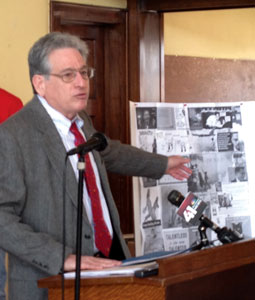 A propaganda broadsheet has been produced and distributed by a group calling itself the “Occupy Kansas City Journal.” Leonard Zeskind, president of the Institute for Research & Education on Human Rights, reports the broadsheet contains assertions usually reserved to the Aryan Nations and Ku Klux Klan. One panel of this broadsheet contains a depiction of a stereotypical Jew along with words: “So what have those ‘Great Humanitarians,’ the Jews, been pouring into the well of white culture over the past half century.”
A propaganda broadsheet has been produced and distributed by a group calling itself the “Occupy Kansas City Journal.” Leonard Zeskind, president of the Institute for Research & Education on Human Rights, reports the broadsheet contains assertions usually reserved to the Aryan Nations and Ku Klux Klan. One panel of this broadsheet contains a depiction of a stereotypical Jew along with words: “So what have those ‘Great Humanitarians,’ the Jews, been pouring into the well of white culture over the past half century.”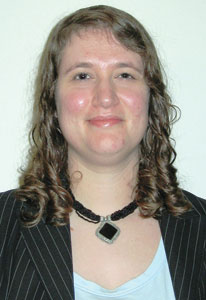 Congregation Beth Torah has hired Rebecca Reice to fill the position of rabbi educator that is being vacated by Rabbi Vered Harris in June. Reice, who will be ordained by Hebrew Union College-Jewish Institute of Religion in Los Angeles at the end of May, will assume her duties at Beth Torah on July 1.
Congregation Beth Torah has hired Rebecca Reice to fill the position of rabbi educator that is being vacated by Rabbi Vered Harris in June. Reice, who will be ordained by Hebrew Union College-Jewish Institute of Religion in Los Angeles at the end of May, will assume her duties at Beth Torah on July 1.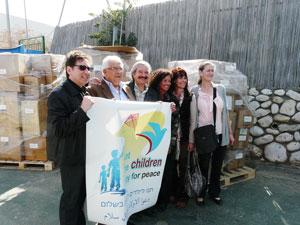 Put down the guns and pick up a soccer ball.
Put down the guns and pick up a soccer ball. TWINKLE TOES — For the second year in a row the Kansas City Jewish community has had a representative invited to perform in KU Student Union Activities’ “Dancing with the Stars.” KU Hillel Executive Director Jay Lewis was paired with Bridget Qandil, the owner of Camelot Ballroom in Overland Park, in the event held earlier this month. Lewis and his partner did a Broadway routine to “Oh What a Night,” a Frankie Valli hit from the musical “Jersey Boys.” Lewis said he had a blast. “I was nominated to participate by a large group of Hillel students so I was happy to represent them and KU Hillel in this event. There were over 500 people in the Kansas Union Ballroom. It was fun to do something completely outside of my comfort zone and I really enjoyed how much the students and my family enjoyed that I was doing it.” Publicity before the event noted that Lewis’ prior dancing experience was limited to watching “So You Think You Can Dance” and dancing in his living room with his wife and two kids, Keaton and Mckenna. On the night of the competition, Lewis had a large group of supporters sitting in the audience. Many of KU Hillel’s student leaders showed up with signs and banners to cheer him on. Lewis danced exceedingly well and received all “8s” from the judges. While Lewis unfortunately lost to KU football player Daymond Patterson, he gave KU Hillel great exposure to the KU community.
TWINKLE TOES — For the second year in a row the Kansas City Jewish community has had a representative invited to perform in KU Student Union Activities’ “Dancing with the Stars.” KU Hillel Executive Director Jay Lewis was paired with Bridget Qandil, the owner of Camelot Ballroom in Overland Park, in the event held earlier this month. Lewis and his partner did a Broadway routine to “Oh What a Night,” a Frankie Valli hit from the musical “Jersey Boys.” Lewis said he had a blast. “I was nominated to participate by a large group of Hillel students so I was happy to represent them and KU Hillel in this event. There were over 500 people in the Kansas Union Ballroom. It was fun to do something completely outside of my comfort zone and I really enjoyed how much the students and my family enjoyed that I was doing it.” Publicity before the event noted that Lewis’ prior dancing experience was limited to watching “So You Think You Can Dance” and dancing in his living room with his wife and two kids, Keaton and Mckenna. On the night of the competition, Lewis had a large group of supporters sitting in the audience. Many of KU Hillel’s student leaders showed up with signs and banners to cheer him on. Lewis danced exceedingly well and received all “8s” from the judges. While Lewis unfortunately lost to KU football player Daymond Patterson, he gave KU Hillel great exposure to the KU community.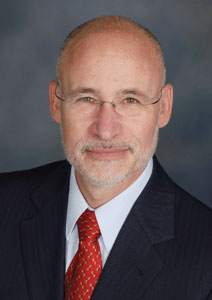 “It’s not your grandfather’s seder,” says Rabbi Arthur Nemitoff when describing the Community Second Night of Passover Seder sponsored by the Rabbinical Association of Greater Kansas City, Jewish Family Services and supported by congregations. It takes place at 6:30 p.m. Saturday, April 7, at The Temple, Congregation B’nai Jehudah.
“It’s not your grandfather’s seder,” says Rabbi Arthur Nemitoff when describing the Community Second Night of Passover Seder sponsored by the Rabbinical Association of Greater Kansas City, Jewish Family Services and supported by congregations. It takes place at 6:30 p.m. Saturday, April 7, at The Temple, Congregation B’nai Jehudah.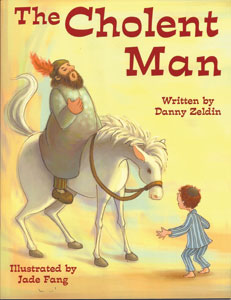 If you are a fan of children’s books, cholent or books written by people with Kansas City ties, you’ll want to seek out “The Cholent Man,” written by Danny Zeldin.
If you are a fan of children’s books, cholent or books written by people with Kansas City ties, you’ll want to seek out “The Cholent Man,” written by Danny Zeldin.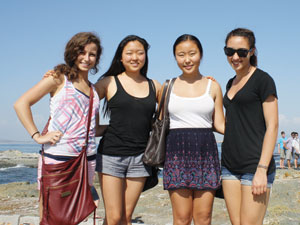 A member of the Jewish community, 17-year-old Sonia Larbi-Aissa, competed among the world’s best and brightest during an international debate in South Africa this January.
A member of the Jewish community, 17-year-old Sonia Larbi-Aissa, competed among the world’s best and brightest during an international debate in South Africa this January.